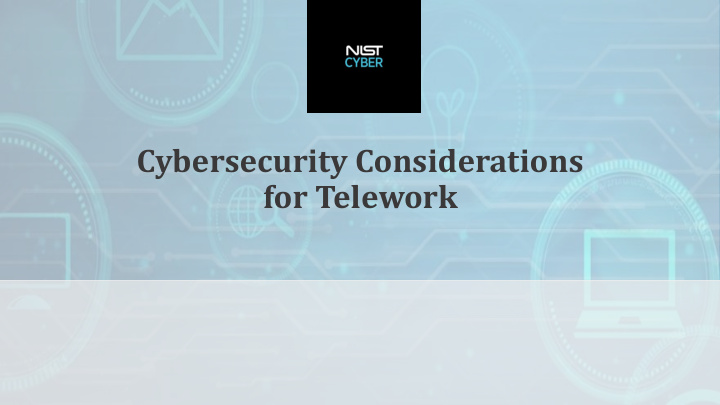



Cybersecurity Considerations for Telework
Security for Enterprises
Enterprise Planning Plan telework-related security policies and controls based on a zero-trust model. Encrypt client devices’ storage, encrypt all sensitive data stored on client • devices, or don’t store sensitive data on client devices Use strong authentication, preferably multi-factor, for enterprise access • • Use encryption technologies to protect the confidentiality and integrity of communications Authenticate each endpoint to the other to verify their identities • Develop a telework security policy that defines telework, remote access, and BYOD requirements. Define in the policy which forms of remote access are permitted and how • the remote access servers will be administered • Make risk-based decisions about what levels of remote access should be permitted from which types of telework client devices
Enterprise Implementation Ensure that remote access servers are secured effectively and configured to enforce telework security policies. Keep remote access servers fully patched • Only allow remote access servers to be managed from trusted hosts by authorized • administrators Carefully choose the placement of each remote access server • Secure organization-controlled telework client devices against common threats, and maintain their security regularly. Ensure all types of telework client devices are secured, including smartphones • and tablets Include all of the local security controls used for non-telework client devices, such • as applying updates promptly, disabling unneeded services, and using anti- malware software (for desktops and laptops) • Use additional security controls, such as encrypting sensitive data stored on the devices
Additional Resources NIST SP 800-46 Revision 2, Guide to Enterprise Telework, Remote • Access, and Bring Your Own Device (BYOD) Security NIST SP 800-77 Revision 1 (Draft), Guide to IPsec VPNs • NIST SP 800-52 Revision 2, Guidelines for the Selection, Configuration, • and Use of Transport Layer Security (TLS) Implementations NIST SP 800-111, Guide to Storage Encryption Technologies for End User • Devices NIST SP 800-124 Revision 1, Guidelines for Managing the Security of • Mobile Devices in the Enterprise NIST SP 800-40 Revision 3, Guide to Enterprise Patch Management • Technologies NIST SP 1800-4, Mobile Device Security: Cloud and Hybrid Builds • NIST SP 1800-21 (Draft), Mobile Device Security: Corporate-Owned • Personally-Enabled (COPE)
Security & Privacy
Virtual Meeting Security • First Rule: use common sense • Follow your organization’s rules • Consider what security is necessary • Not all calls are created equal • Low o Know who’s on the call • Medium o Basic security steps go a long way • High o Use extra precautions
Telework Security Basics • First Rule: use common sense • Follow your organization’s rules • Use a VPN • Secure your devices • Basic hygiene, basic security – still essential • Watch for unusual activity
Additional Resources Blogs • https://www.nist.gov/blogs/cybersecurity-insights/preventing- eavesdropping-and-protecting-privacy-virtual-meetings • https://www.nist.gov/blogs/cybersecurity-insights/telework-security- basics
Recommend
More recommend